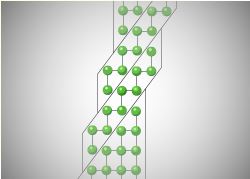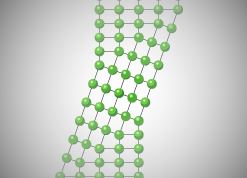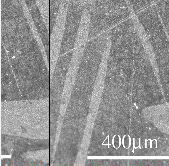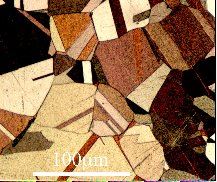Re-use of this resource is governed by a Creative Commons
Attribution-
NonCommercial-ShareAlike 4.0 International
https://creativecommons.org/licenses/by-nc-sa/4.0/
NonCommercial-ShareAlike 4.0 International
https://creativecommons.org/licenses/by-nc-sa/4.0/
Deformation
Twinning
Deformation
Twinning
Deformation twinning
When a stress is applied to a crystalline material deformation
occurs. The deformation can be absorbed by the material in several ways:
Slip
Crystal planes slide past each other by means of dislocations gliding through the material. Slip is an irreversible deformation. (In this animation, the actual dislocations are not shown, and all that is depicted is the fact that the strain is localised to specific planes, on which "sliding" occurs.)
Crystal planes slide past each other by means of dislocations gliding through the material. Slip is an irreversible deformation. (In this animation, the actual dislocations are not shown, and all that is depicted is the fact that the strain is localised to specific planes, on which "sliding" occurs.)
Deformation twinning
Each atom moves only a small distance relative to its neighbour but in a well defined way. (In this animation, the motion of atoms is shown taking place relatively slowly, whereas in practice it is very fast - ie at approximately the speed of sound in the material)
Each atom moves only a small distance relative to its neighbour but in a well defined way. (In this animation, the motion of atoms is shown taking place relatively slowly, whereas in practice it is very fast - ie at approximately the speed of sound in the material)
Click on either diagram to see more


Slip
The animation shows how planes in a crystal structure
are moved by a dislocation passing through the material. The dislocation
itself is not shown. Many dislocations passing through a material leads
to irreversible plastic deformation. More information on dislocations
can be found here:
Dislocation TLP
Slip in an fcc crystal structure
Slip Plane
(111)
(111)
Slip direction
110 planes
Twinning
Deformation twinning is described by the twinning plane
and a twinning direction. Atoms move in the twinning direction by a
displacement, generating twinning shear. The twin's structure is a mirror
image of the parent structure about the twinning plane. The distance
moved is such that a fully coherent boundary is formed, that is each
atom is in the correct position related to the original system and the
twin lattice.
Twinning in an fcc crystal structure
Twinning Plane
(111)
(111)
Twinning direction
(112)
(112)
110 plane
Lattice points
Arrows
Arrows
The shape of the twin is governed by the elastic strain
which developes as it grows within the parent grain. The twin grows
in a thin, sharply pointed plate as this minimises the elastic strain
energy producing a lenticular shaped twin. This lenticular shape differs
from annealing twins which form parallel sided twins to minimise interfacial
energy.
Deformation twins
Annealing twins


Sample of cold worked Zn showing deformation twinning
as an alternative to dislocation motion. Twinning is commonly observed
in structures of low crystallographic symmetry (eg. insufficient number
of independant slip systems) such as hcp metals like Zn. (Micrograph
Library sample 41)
Sample of Brass (Cu-30wt% Zn) showing annealing twins
produced as a result of recrystalisation and grain growth. Recrystallisation
(at high temperatures) allows sufficiant time for a diffusional rearrangement
of the atoms to form twins with parallel sides (Micrograph Library sample
430)